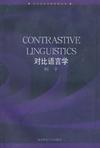对比语言学
出版时间:2008-7 出版社:南京师范大学出版社 作者:柯平 编 页数:260
Tag标签:无
前言
This work is designed as a textbook for graduate students of English who take the course of Contrastive Linguistics. It may also be used as an introductory reader of contrastive linguistics for students who have little knowledge of linguistics but are interested in the disciplines of contrastive linguistics or appliedlinguistics, in translation studies, foreign or second language teaching, Chinese as a foreign language, or other subjects of study which involve the use of a second language. The work grew out of an attempt to rethink myintroductory course offered to the graduate students specializedin linguistics, translation studies, and teaching methodology atNanjing University. It is written with a one-term course in mindal though, with the addition of some supplementary readings, itcould be used for two terms. Contrastive linguistics is a relatively new area of study.Although many universities and colleges in China and othercountries of the world have included it in their postgraduatecourses for many years, the subject of the course remainsindeterminate to some extent and many explorations made inthis field are still somewhat tentative. While preparing thiscoursebook, I kept reminding myself that a work providingmerely a general survey of the state of the art of this particularbranch of linguistics and its general, "standard" theories wouldnot be of much help to the students: contrast and comparisonare not ends in themselves.
内容概要
This work is designed as a textbook for graduate students of English who take the course of Contrastive Linguistics. It may also be used as an introductory reader of contrastive linguistics for students who have little knowledge of linguistics but are interested in the disciplines of contrastive linguistics or appliedlinguistics, in translation studies, foreign or second language teaching, Chinese as a foreign language, or other subjects of study which involve the use of a second language.
书籍目录
PREFACECHAPTER 1 INTRODUCTION1.1 What is Contrastive Linguistics?1.1.1 Name and Nature1.1.2 Classification1.2 Why Contrastive Linguistics?1.3 History and Development Study QuestionsCHAPTER 2 PRINCIPLES AND PROCEDURES2.1 Basic Assumptions & Hypotheses2.1.1 Transfer: the Psychological Basis of Contrastive Analysis2.1.2 The Strong and Weak Versions of CA Hypothesis2.1.3 The Predictive Power of Contrastive Analysis2.2 Criteria for Comparison2.2.1 The Surface Structure (SS)2.2.2 The Deep Structure (DS)2.2.3 Translation Equivalence2.3 Procedures Study QuestionsCHAPTER 3 PHONETIC & PHONOLOGICAL CONTRASTIVE ANALYSES3.1 Phonetics and Phonology3.2 Contrastive Phonetics3.3 Contrastive Phonology3.3.1 Phonological Contrastive Analysis3.3.2 Two Phonological Models3.4 Suprasegmental Contrastive AnalysisStudy QuestionsCHAPTER 4 LEXlCAL CONTRASTIVE ANALYSIS4.1 Contrastive Lexical Morphology4.2 Contrastive Lexical Semantics4.2.1 Motivation of Words4.2.2 Sense Relationships4.2.3 Semantic Features4.3 Three Active AreasStudy QuestionsCHAPTER 5 GRAMMATICAL CONTRASTIVE ANALYSIS5.1 Contrastive Analysis of Inflectional Morphology5.1.1 Aspect5.1.2 Case5.1.3 Gender5.1.4 Mood5.1.5 Number5.1.6 Person5.1.7 Tense5.1.8 Voice5.2 Syntactic Contrastive Analysis5.2.1 Structuralist Approach (Surface-structure Contrasts)5.2.2 Generative Approach Study QuestionsCHAPTER 6 TEXTUAL CONTRASTIVE ANALYSIS6.1 Text and Discourse6.2 Defining Characteristics of the Text6.3 Contrastive Analysis of Textual Cohesion6.3.1 Semantic Cohesion6.3.2 Structural Cohesion6.3.3 Different Languages Preferring Different Cohesive Devices6.4 Contrastive Analysis of Textual Coherence Study QuestionsCHAPTER 7 PRAGMATIC CONTRASTIVE ANALYSIS7.1 Speech Act Theory (Unilateral Communication)7.1.1 Speech Acts7.1.2 Felicity Conditions7.2 Conversational Interaction (Bilateral Communication)7.2.1 Structural Components of Conversation7.2.2 Principles of Conversational OrganizationStudy QuestionsREFERENCESINDEX
章节摘录
possible bases for prediction: either one can predict bygeneralization from observed instances, or, more ambitiously, onecan predict one phenomenon on the basis of observation of someother phenomenon. The error analyst chooses the first path: havingobserved errors like *I must to go, *I should to learn hegeneralizes to predict the likely occurrence of *I can to speakEnglish. The contrastivist prefers the second path: on the basis ofan analysis of two related linguistic systems he predicts learnersbehavior. In other words, error analysts employ the inductivemethod in their prediction while contrastivists resort to deductivemethod in their prediction (James, 1980:181-182). We should make a distinction at this point concerning the"prediction of error." In fact this phrase is ambiguous: it can meaneither prediction that there will be error or prediction of the formof that error. Obviously, to claim that contrastive analyses havepredictive capacity of the second kind would, given the present"state of the art," be quite presumptuous. So, rather than riskmaking wrong predictions about the form of errors, contrastivistshave more cautiously made predictions of an either/or type:learners with a certain L1 learning this L2 will produce either x ory types of errors; for example, French speakers tend to use eitherFrench/s,/z/or/t/,/d/for L2 English/0/,/6/. There are, of course, limitations on the numbers of learnererrors that contrastive analyses can predict, limitations stemmingfrom the fact that notall errors are the reset of L1 interference;that is, are interlinguaI errors (James, 1980:146).
图书封面
图书标签Tags
无
评论、评分、阅读与下载
